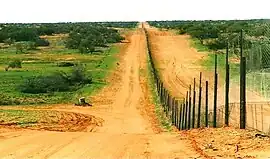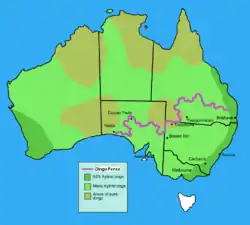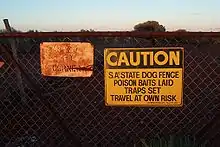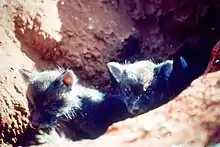Dingo Fence
The Dingo Fence or Dog Fence is a pest-exclusion fence in Australia to keep dingoes out of the relatively fertile south-east part of the continent (where they have largely been exterminated) and protect the sheep flocks of southern Queensland. It is one of the longest structures in the world. It stretches 5,614 kilometres (3,488 mi)[1] from Jimbour on the Darling Downs near Dalby through thousands of kilometres of arid land ending west of Eyre peninsula on cliffs of the Nullarbor Plain[2] above the Great Australian Bight[3] near Nundroo.[4] It has been partly successful, though dingoes can still be found in parts of the southern states. Although the fence has helped reduce losses of sheep to predators, this has been countered by holes in fences found in the 1990s through which dingo offspring have passed[2] and by increased pasture competition from rabbits and kangaroos.
| Dingo Fence | |
|---|---|
| Australia | |
 Dingo Fence on the 29th parallel south in Sturt National Park (right of fence), looking east from Cameron Corner | |
 A portion of the dingo fence near Coober Pedy, South Australia | |
 Route of the Dingo Fence (purple) | |
| Type | Fence |
| Length | 5,614 km |
| Site history | |
| Built | 1880-85 |
| Materials | Wire mesh |

History


The earliest pest exclusion fences in Australia were created to protect small plots of cropland from the predation by marsupials. In the 1860s and 1870s, introduced rabbit populations began to spread rapidly across southern Australia. By 1884, a rabbit-proof fence was built. Having been unsuccessful at keeping rabbits out, and more successful at keeping out pigs, kangaroos, emus and brumbies, and as more sheep farms were established, the interest for a dingo-proof barrier increased enough that government funds were being used to heighten and expand the fence. In 1930, an estimated 32,000 km of dog netting in Queensland alone was being used on top of rabbit fences. Prior to 1948, the idea of a Dingo Barrier Fence Scheme had not come into fruition as a statewide project for which annual maintenance and repair were kept. Since this time, there have been pushes to move away from a method of barrier-exclusion to complete extinction of the dingo and wild-dog cross-breeds. Poisoning the species with compound 1080 (sodium monofluoroacetate) baits has been seen as a much cheaper alternative than fence maintenance. A compromise in the form of the continued use of poison and the shortening of the fence from its previous length of over 8000 km has been made.
In 2009 as part of the Q150 celebrations, the dingo fence was announced as one of the Q150 Icons of Queensland for its role as an iconic "innovation and invention".[5]
In 2011 the Liberal MP for Stuart, Dan van Holst Pellekaan, called for a A$200 bounty on dingoes.[6]
Geography
The 2,500 km (1,553 mi) section of the fence in Queensland is also known as the Great Barrier Fence or Wild Dog Barrier Fence 11. It is administered by the Department of Agriculture and Fisheries. The Wild Dog Barrier Fence staff consists of 23 employees, including two-person teams that patrol a 300 km (186 mi) section of the fence once every week. There are depots at Quilpie and Roma.[7]
The Queensland Border Fence stretches for 394 km (245 mi) westwards along the border with New South Wales, into the Strzelecki Desert. The fence passes the point where the three states of Queensland, New South Wales and South Australia meet (Cameron Corner). At this point, it connects with the South Australian Border Fence, which runs for 257 km (160 mi) southwards along the border with New South Wales,[8] these two sections are managed by the New South Wales Wild Dog Destruction Board.[9] It then joins a section known as the Dog Fence in South Australia, which is 2,225 km (1,383 mi) long.[1]
Physical design
The fence varies in construction. Mostly it is made of 180-centimetre (6 ft) high wire mesh, but some sections in South Australia comprise multi-strand electric fence.[10] The fence line on both sides is cleared to a 5 m (5.5 yd; 16 ft) width. Sheep and cattle stations protected by the fence are exceptionally large.
Parts of the Dingo Fence are lit at night by 86 mm (3.4 in) cold cathode fluorescent lamps which are alternately red and white. They are powered by long life batteries which are charged by photovoltaic cells during the day.[11] At minor and farm crossings, a series of gates allow vehicles to pass through the fence.[12] Where the fence intersects major roads and highways, cattle grids are used to allow high-speed vehicles through.
Environmental impact

It seems that there are fewer kangaroos and emus on the northwestern side of the fence where the dingoes are, suggesting that the dingoes' presence reduces the populations of those animals.[13] It has also been suggested that the larger kangaroo populations inside the fence have been caused by the lack of dingo predation, and competition for food leads to lower sheep stocking rates than would be possible without the fence.
Believed to have been introduced into Australia by Aboriginal peoples between 4,600 and 18,300 years ago,[14] the dingo's status as a native or introduced species in Australia has been a controversy. According to Mike Letnic of UNSW, the dingo, as Australia's top predator, has an important role in maintaining the balance of nature. Where dingoes had been excluded by the fence, Letnic found reduced biodiversity, with fewer native mammals.[15]
Although the fence has helped reduce the loss of sheep to predators, the exclusion of dingoes has allowed for increased pasture competition from rabbits, kangaroos and emus. Sheep are being lost to increasing numbers of feral dogs.
Drone and satellite technology have illustrated how removing dingos changes vegetation growth.[16]
Gallery
 Dingo Barrier fence, near Bell, Queensland. 2018
Dingo Barrier fence, near Bell, Queensland. 2018 Dingo Barrier fence crossing, near Bell, Queensland. 2018
Dingo Barrier fence crossing, near Bell, Queensland. 2018 Dingo Barrier fence sign, near Bell, Queensland, Australia. Sign on gate for stock adjacent to cattle grid. 2018
Dingo Barrier fence sign, near Bell, Queensland, Australia. Sign on gate for stock adjacent to cattle grid. 2018
References
- Downward, R.J.; Bromell, J.E. (March 1990). "The development of a policy for the management of dingo populations in South Australia". Proceedings of the Fourteenth Vertebrate Pest Conference 1990. University of Nebraska - Lincoln. Retrieved 31 August 2009.
- "Dingo numbers out of control: pastoralists". ABC News (Australia). Australian Broadcasting Corporation. 24 October 2009. Retrieved 2 November 2009.
- Helps, Y.L.M.; Moller, J.; Kowanko, I.; Harrison, J.E.; O'Donnell, K.; de Crespigny, C. (October 2008). "Road Safety Grant Report 2008-01 - Aboriginal People Travelling Well: Issues of safety, transport and health" (PDF). Australian Government - Department of Regional Development and Local Government. Archived from the original (PDF) on 6 July 2011. Retrieved 2 November 2009.
- "South Australia's National Parks Guide" (PDF). Government of South Australia - Department for Environment and Heritage. 2008–2009. Archived from the original (PDF) on 26 October 2009. Retrieved 2 November 2009.
- Bligh, Anna (10 June 2009). "PREMIER UNVEILS QUEENSLAND'S 150 ICONS". Queensland Government. Archived from the original on 24 May 2017. Retrieved 24 May 2017.
- "$200 a head bounty for dingoes". The Advertiser. Archived from the original on 24 October 2016. Retrieved 12 September 2019.
- Queensland Department of Natural Resources and Mines (29 September 2005). "History of barrier fences in Queensland" (PDF). Retrieved 31 August 2009.
- "Wild Dog Destruction Act 1921 - Sect 3 (updated)". New South Wales Consolidated Acts. Australasian Legal Information Institute. 6 July 2009. Archived from the original on 6 October 2011. Retrieved 31 August 2009.
- Druce, Alex (31 May 2017). "Off the fence: Wild Dog Destruction Board resists LLS merger". The Land. North Richmond. Retrieved 28 February 2021.
- Yelland, Leith; Fraser, Patricia (2012). Holding the line: a history of the South Australian Dog Fence Board, 1947 to 2012 (PDF). Adelaide: Department of Primary Industries and Regions SA. p. 53. ISBN 978-1-921399-37-4.
- News – JKL Components Corporation Archived 27 October 2005 at the Wayback Machine
- Spennemann, Dirk HR (17 July 2009). "Images of Warri Warri Gate". Flickr.com. Retrieved 12 September 2019.
- A. R. Pople; G. C. Grigg; S. C. Cairns; L. A. Beard; P. Alexander (2000). "Trends in the numbers of red kangaroos and emus on either side of the South Australian dingo fence: evidence for predator regulation?" (PDF). Wildlife Research. 27 (3): 269 - 276. doi:10.1071/WR99030.
- Oskarsson, Mattias C. R.; Klütsch, Cornelya F. C.; Boonyaprakob, Ukadej; Wilton, Alan; Tanabe, Yuichi; Savolainen, Peter (7 September 2011). "Mitochondrial DNA data indicate an introduction through Mainland Southeast Asia for Australian dingoes and Polynesian domestic dogs". Proceedings of the Royal Society B: Biological Sciences. 279 (1730): 967–974. doi:10.1098/rspb.2011.1395. PMC 3259930. PMID 21900326.
- Kean, Zoe (9 February 2023). "The dingo fence is the world's longest and has cascading effects on the Australian environment". ABC News. Retrieved 4 March 2023.
- "A Reminder of a Desert's Past, Before Dingo Removal". 8 April 2021. Retrieved 16 April 2021.
Further reading
- Dickman, Chris; Ritchie, Euan; Newsome, Thomas (6 March 2023). "Let's move the world's longest fence to settle the dingo debate". The Conversation.
- Ginis, Elizabeth (5 May 2022). "The dog fence: What future for this iconic but contentious barrier?". Australian Geographic.
- MacDonald, James (12 February 2018). "The unexpected result of Australia's Dingo Fence". JSTOR Daily.
- "Wild Dog Barrier Fence: Landmarks and buildings". Outback Queensland. 8 March 2023.